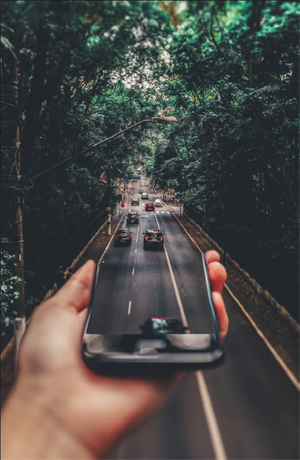Are you someone who’s spent years honing their craft? Is your photography portfolio brimming with creative shots that leave people amazed? If the answer to both of those questions is yes but you still find yourself struggling to get your business seen online, you’re in the right place!
According to a study, Google accounted for 91% of site visits in the US in Q3 2017. Considering the online-first world we now live in, this makes it essential that your photography business — or any business for that matter — invest in Digital Marketing.
Still not convinced? Google reported that 46% of all Google search queries have local intent. This means that almost half of the people who search for things online are looking for local solutions to their problems. This has major implications for your photography business.
Once your photography page starts ranking on the first page of SERPs, the rest is up to your portfolio and web content. Bring it all together and hook, line, and sinker, you’ve netted yourself a sale.
So how do you go about optimizing your photography business for Digital Marketing (also SEO) and make it a huge brand and a commercial success?
A Lowdown on Photography SEO
Here are the most important photography SEO strategies that your business needs to employ:
The Basics
You can’t optimize for a search engine’s algorithm if your site isn’t even listed on that search engine. To start off, do a basic “site:” search. Type in “site:” in Google Search and add your domain in front of it. If your website shows up, congratulations! You’re good to go.

Secondly, it’s important to be mindful of what platform your website is using. While search engines are platform-agnostic for the most part, you can’t get away with using a questionable one. WordPress, Squarespace, and Wix are all great choices.
When looking for a platform for your photography website, make sure that you’re aware of what features you need. For example, if you’re not the most tech savvy person but need customizability, Wix is a great choice because of their WYSIWYG (What You See Is What You Get) website editor. If you’re looking for advanced features and a platform that has been around for a very long time and has proven resources, WordPress is your best bet.
Another thing you need to ensure is that your website theme and your portfolio form a cohesive aesthetic. Customers are very sensitive to jarring design, and this is especially true for photography websites, since it’s a photographer’s job to know what good aesthetic looks like.
One Site to Rule Them All
One of the cardinal sins of SEO is splitting your site into multiple domains. Why, you ask? Among the more than 200 metrics search engines use to rank a website, “domain authority” is one of them.
Domain authority refers to how credible your website is in the industry, based on how much traffic it gets, whether it answers consumers’ questions, how many backlinks you have coming in, etc. When you split your photography site into two domains, for example, having a different main site and a photography blog, you also split your domain authority among them. This is bad news for both your domains.
If you already have two domains, it may be a good idea to merge them while appropriately redirecting traffic so you don’t lose either of your audiences.
SEO for your Images
Image SEO is unsurprisingly more important for photographers than anyone else. The term refers to a whole host of practices that optimize your website so search engines find it to be relevant and rank it higher.

Firstly, you need to be mindful of image size. Page load speed is one of the most important SEO metrics. This means that you need to make sure that your page loads within six seconds of a customer clicking through to it from Google! And while we know the temptation to upload full resolution stills is omnipresent, doing so will only hurt your photography business. Limit all your photos to be under 1MB.
The second thing you need to focus on is image names. If a search engine sees that an image is called “JPEG_43643634,” it tells it nothing about what the image is showing. This means that there’s a slim chance of it being listed on Google Images, for example.
For prolific photographers, giving each image a unique name is near impossible. But it’s important to give enough of them relevant names to make your page relevant for those keywords. If you do food photography, and have an image of a stack of homemade oatmeal cookies for instance, name it “homemade-oatmeal-cookies,” or something along those lines.
Lastly, make sure the content that’s around image pages is also relevant. For example, if you have a gallery of photos around a wedding shoot you did, make sure the content is using keywords people would search for; “wedding photography,” “hire a wedding photographer,” etc.
Local SEO the House Down
Being on Google’s 3-pack business listings is every business’s dream. This refers to the three listings on top of Google Search that show up with a map location to them. 50% of clicks come from these listings when a search has local intent. How do you get listed on it?
The first step is to have a Google My Business account which you regularly post on. The platform is free but has a ton of benefits associated with it. Google queries the platform every time someone makes a local search, meaning that having a local citation on GMB can drive a ton of business to your photography studio.
Make sure you list the correct address, business hours, etc. Also, it’s important to augment GMB listings with other directories, such as a Facebook page, Bing Places, etc.
Local SEO also involves optimizing for long-tailed keywords. These include keywords like “OK Google, show me photography businesses in Burlington, Vermont,” for example. You probably noticed that we used a voice search related keyword. This is because most voice searches usually have local intent and utilize long-tailed keywords.
It’s also important to incentivize existing clients to leave reviews. Review directories can greatly impact your ranking. Giving happy clients a discount if they leave a review is a great way to rank higher.
The Photography Digital Marketing Grab Bag
There are a bunch of other strategies you can use to really propel your photography site to the top of SERPs.
Start submitting select photos to other websites. Make sure that you choose your very best work, and that those sites link back to yours. This will greatly increase backlinks to your photography website.
You also need to augment your existing strategies with a stellar social media presence. Represent every project you take up on social media. Make sure you target all the most popular platforms (Facebook, Instagram, Pinterest, etc.) and that you use the appropriate hashtags for discovery. Remember, the key is persistence.
Do you find doing your own photography digital marketing overwhelming? That’s where the experts at Search Berg come in. The company is one of the leading agencies for affordable SEO marketing for photographers. They provide cutting edge local SEO services to photographers to help their website rank higher than ever. Learn more about them here.
Jospeh Dyson is a digital marketing professional working for SearchBerg. SearchBerg offers comprehensive digital marketing solutions such as professional small business SEO services, reputation management and social media marketing and quality link building services for companies across various industries including e-commerce, real estate, healthcare, education and retail.
 CoalesceIdeas Web and graphic design ideas for inspiration
CoalesceIdeas Web and graphic design ideas for inspiration



